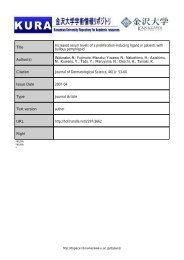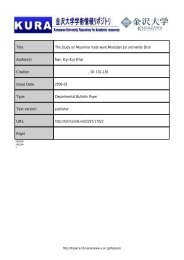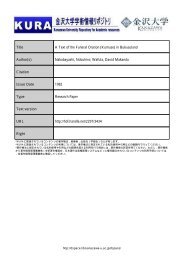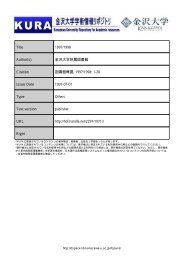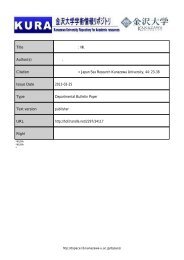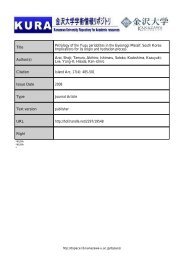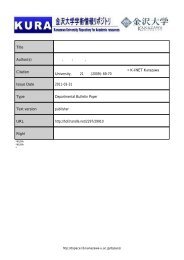Title Krafft temperature and enthalpy of solution of N-acyl amino acid ...
Title Krafft temperature and enthalpy of solution of N-acyl amino acid ...
Title Krafft temperature and enthalpy of solution of N-acyl amino acid ...
You also want an ePaper? Increase the reach of your titles
YUMPU automatically turns print PDFs into web optimized ePapers that Google loves.
1<br />
Colloid Polymer Sci. 2002 in press<br />
<strong>Krafft</strong> Temperature <strong>and</strong> Enthalpy <strong>of</strong> Solution <strong>of</strong> N-Acyl<br />
Amino Acid Surfactants <strong>and</strong> Their Racemic<br />
Modifications: Effect <strong>of</strong> the Amino Acid Residue<br />
Akio Ohta, Noriaki Ozawa, Satoru Nakashima, Tsuyoshi Asakawa, <strong>and</strong><br />
Shigeyoshi Miyagishi<br />
Department <strong>of</strong> Chemistry <strong>and</strong> Chemical Engineering, Faculty <strong>of</strong><br />
Engineering, Kanazawa University, Ishikawa 920-8667, Japan<br />
Mailing address:<br />
Akio Ohta<br />
Department <strong>of</strong> Chemistry <strong>and</strong> Chemical Engineering, Faculty <strong>of</strong><br />
Engineering, Kanazawa University, 2-40-20 Kodatsuno, Kanazawa,<br />
Ishikawa 920-8667, Japan<br />
e-mail address<br />
akio-o@t.kanazawa-u.ac.jp<br />
1. To whom the correspondence should be addressed.
Abstract<br />
The <strong>Krafft</strong> <strong>temperature</strong>s <strong>and</strong> the enthalpies <strong>of</strong> <strong>solution</strong> <strong>of</strong> six kinds <strong>of</strong><br />
N-hexadecanoyl <strong>amino</strong> <strong>acid</strong> surfactant (Gly, Ala, Val, Leu, Ile, <strong>and</strong> Phe)<br />
were obtained from both solubility measurements <strong>and</strong> differential scanning<br />
calorimetry. It was shown that the <strong>Krafft</strong> <strong>temperature</strong> <strong>of</strong> N-hexadecanoyl<br />
<strong>amino</strong> <strong>acid</strong> surfactant increased with decreasing size <strong>of</strong> the <strong>amino</strong> <strong>acid</strong><br />
residue except for the case <strong>of</strong> phenylalanine. On the other h<strong>and</strong>, the<br />
<strong>enthalpy</strong> <strong>of</strong> <strong>solution</strong> was endothermic <strong>and</strong> increased with decreasing size <strong>of</strong><br />
the <strong>amino</strong> <strong>acid</strong> residue except for the cases <strong>of</strong> glycine <strong>and</strong> phenylalanine.<br />
It was found from these results that the D-L interaction was superior to the<br />
L-L interaction in solid state <strong>of</strong> N-hexadecanoyl <strong>amino</strong> <strong>acid</strong> surfactant salt<br />
for both the alanine <strong>and</strong> phenylalanine systems. It was suggested by ab<br />
initio calculations that the difference <strong>of</strong> the magnitude <strong>of</strong> the<br />
peptide-peptide hydrogen bonding was dominant factor for the chiral<br />
effect.<br />
Keywords N-Acyl <strong>amino</strong> <strong>acid</strong> surfactant • <strong>Krafft</strong> <strong>temperature</strong> •<br />
Enthalpy <strong>of</strong> <strong>solution</strong> • Amino <strong>acid</strong> residue • Chiral effect<br />
Introduction<br />
N-Acyl <strong>amino</strong> <strong>acid</strong> surfactants, which are anionic <strong>amino</strong> <strong>acid</strong>-type<br />
surfactants, are <strong>of</strong> immense importance both from the industrial <strong>and</strong> the<br />
domestic viewpoints because <strong>of</strong> their biodegradability <strong>and</strong> low toxicity [1].<br />
Micelle formation is an important property <strong>of</strong> surfactants, <strong>and</strong> has been the<br />
subject <strong>of</strong> intense research [2-8]. The aggregation number <strong>of</strong> a micelle is<br />
same order as that for general anionic surfactants (ca. 40~100) <strong>and</strong><br />
2
increases with increasing concentrations <strong>of</strong> surfactant <strong>and</strong>/or salt [4,5,8].<br />
Furthermore N-<strong>acyl</strong> <strong>amino</strong> <strong>acid</strong> surfactants are useful for chiral<br />
discrimination. There are two types <strong>of</strong> chiral discrimination; one in which<br />
the D-L interaction is more favorable, <strong>and</strong> a second where the D-D or L-L<br />
interaction is more favorable. The latter is especially important from the<br />
st<strong>and</strong>point <strong>of</strong> improving optical purity. The chiral discrimination <strong>of</strong><br />
N-<strong>acyl</strong> <strong>amino</strong> <strong>acid</strong> surfactants has been reported in the solid state [9,10],<br />
Langmuir monolayer [11-15], <strong>and</strong> even for micelles [2,16]. This effect in<br />
the exp<strong>and</strong>ed state <strong>of</strong> a Langmuir monolayer <strong>and</strong> micelle, however, is much<br />
smaller than in the solid <strong>and</strong> condensed state <strong>of</strong> a Langmuir monolayer.<br />
However, the ability <strong>of</strong> N-<strong>acyl</strong> <strong>amino</strong> <strong>acid</strong> surfactants to act as chiral<br />
selectors have been confirmed for both micelles [17-19] <strong>and</strong> copper<br />
complexes [20,21]. Therefore, these compounds have enormous potential<br />
as column packing material for chiral chromatography.<br />
In this study, the effects <strong>of</strong> the size <strong>of</strong> the hydrophobic residue <strong>of</strong><br />
N-hexadecanoyl <strong>amino</strong> <strong>acid</strong> surfactants on the <strong>Krafft</strong> <strong>temperature</strong> (KT) <strong>and</strong><br />
the <strong>enthalpy</strong> <strong>of</strong> <strong>solution</strong> are investigated by both solubility measurements<br />
<strong>and</strong> differential scanning calorimetry (DSC). It is known that the KT is an<br />
important property <strong>of</strong> a surfactant because micelle particles appear in<br />
aqueous <strong>solution</strong> only above the KT. This has obvious applications in<br />
industrial processes where the KT is critical then it is also important to<br />
investigate the effect <strong>of</strong> the <strong>amino</strong> <strong>acid</strong> residue on the KT <strong>of</strong> N-Acyl <strong>amino</strong><br />
<strong>acid</strong> surfactants. In addition, we also studied the chiral effects <strong>of</strong><br />
N-hexadecanoyl <strong>amino</strong> <strong>acid</strong> surfactant on the KT <strong>and</strong> the <strong>enthalpy</strong> <strong>of</strong><br />
<strong>solution</strong>. These are discussed from the viewpoint <strong>of</strong> homochiral (L-L or<br />
D-D) <strong>and</strong> the heterochiral (D-L) interactions by use <strong>of</strong> theoretical<br />
calculations.<br />
3
Experimental<br />
Materials<br />
Glycine (Gly), L-alanine (Ala), L-valine (Val), L-leucine (Leu),<br />
L-isoleucine (Ile), L-phenylalanine (Phe) <strong>and</strong> their racemic mixtures<br />
(DL-form) were purchased from Peptide Institute, Inc. <strong>and</strong> Nacalai Tesque,<br />
Inc., <strong>and</strong> used without further purification. N-Hexadecanoyl <strong>amino</strong> <strong>acid</strong>s<br />
(C16-<strong>amino</strong> <strong>acid</strong>; see Fig.1) were synthesized by the reaction <strong>of</strong> an <strong>amino</strong><br />
<strong>acid</strong> with hexadecanoyl chloride as described previously [2] <strong>and</strong> were<br />
re-crystallized from mixtures <strong>of</strong> either diethyl ether-ethanol or<br />
acetone-methanol. Their purities were checked by HPLC <strong>and</strong> DSC <strong>and</strong><br />
by observing no minimum on the surface tension vs concentration curves at<br />
298.15 K. The melting points were measured by DSC <strong>and</strong> are listed in<br />
Table 1. They were dissolved in 1mM excess aqueous <strong>solution</strong> <strong>of</strong> sodium<br />
hydroxide. Auramine (guaranteed reagent, Kanto Chemical Co.) was<br />
used as a fluorescence probe for determination <strong>of</strong> critical micelle<br />
concentration (cmc). The concentration <strong>of</strong> the probe molecule was<br />
1! 10 -5 M.<br />
Solubility<br />
The solubility <strong>of</strong> N-hexadecanoyl <strong>amino</strong> <strong>acid</strong> was measured by HPLC<br />
(Japan Optics, BIP-1). After dissolving the N-hexadecanoyl <strong>amino</strong> <strong>acid</strong>s<br />
in an aqueous <strong>solution</strong> <strong>of</strong> 0.4 M NaCl, the <strong>solution</strong>s were kept at 2 ˚C to<br />
deposit the solid Na N-hexadecanoyl <strong>amino</strong> <strong>acid</strong> salts. The addition <strong>of</strong><br />
NaCl was necessary in order to raise the KT above 0 °C for almost all<br />
surfactants. The concentration <strong>of</strong> all the <strong>solution</strong>s prepared was ca. 0.1<br />
4
mM. After the samples reached equilibrium in a thermostat at a given<br />
<strong>temperature</strong>, the supernatant <strong>solution</strong> was pipetted by syringe equipped<br />
with a disc filter (pore size 0.4µm). A reversed phase chromatography<br />
column (Tosoh co. TSKgel ODS-120A) <strong>and</strong> an UV-VIS monitor (Tosoh co.<br />
model UV-8000) were used as a packed column <strong>and</strong> a detector,<br />
respectively. The eluate was a mixed <strong>solution</strong> <strong>of</strong> methanol (80%) <strong>and</strong><br />
30mM aqueous <strong>solution</strong> <strong>of</strong> phosphoric <strong>acid</strong> (20%).<br />
DSC<br />
Differential scanning calorimetry (DSC) experiments were made by<br />
using a DSC7 (Perkin-Elmer) thermal analyzer. A sample <strong>solution</strong> was<br />
prepared in the same way as for the solubility measurements, <strong>and</strong> was<br />
sealed in a Large Volume Capsule (Perkin-Elmer) using an O-ring sealed<br />
60 µl stainless steel container. The experiments were done on the<br />
<strong>solution</strong>s in the concentration range 5 to 20 mM using about 50 mg <strong>of</strong> the<br />
samples. After the samples were kept at 0 °C for 5 hours, they were<br />
heated at a rate <strong>of</strong> 0.5 K/min. At least four runs were performed each<br />
system.<br />
Cmc<br />
Fluorescence measurements were carried out on a Hitachi fluorescence<br />
spectrophotometer F-2000 for determination <strong>of</strong> cmc values <strong>of</strong> N-<strong>acyl</strong> <strong>amino</strong><br />
<strong>acid</strong> surfactants. Excitation <strong>and</strong> emission wavelengths were 410 <strong>and</strong> 470<br />
nm, respectively. The ratio <strong>of</strong> the fluorescence intensity in an aqueous<br />
<strong>solution</strong> containing no surfactant (I 0) against that for a surfactant <strong>solution</strong><br />
(I) was used as indication <strong>of</strong> microviscosity <strong>and</strong> was measured as a<br />
function <strong>of</strong> concentration <strong>of</strong> surfactant <strong>and</strong> <strong>temperature</strong>.<br />
5
Results<br />
Solubility<br />
Figure 2 shows the logarithm <strong>of</strong> the solubility <strong>of</strong> N-hexadecanoyl<br />
<strong>amino</strong> <strong>acid</strong> sodium salts obtained by HPLC as a function <strong>of</strong> <strong>temperature</strong>.<br />
For C16-DL-Ile, its solubility could not be determined because its KT was<br />
below 0 °C. From Figure 2 it can be seen that the solubility rises abruptly<br />
at a particular <strong>temperature</strong> in all systems. The <strong>temperature</strong>s correspond to<br />
the KT <strong>and</strong> these values are summarized in Table 2. The order <strong>of</strong> KT was<br />
C16-Ile < -Leu < -Val < -Phe < -Ala, which increased with decreasing size<br />
<strong>of</strong> residue except for C16-Phe. For the C16-Ala <strong>and</strong> C16-Phe systems,<br />
the KT <strong>of</strong> the DL form was higher than that <strong>of</strong> the L form. Conversely,<br />
for the C16-Val, C16-Leu, <strong>and</strong> C16-Ile systems the KT <strong>of</strong> the DL form was<br />
lower than that <strong>of</strong> the L form. Furthermore the solubility <strong>of</strong> C16-Phe<br />
below the KT was smaller one order <strong>of</strong> magnitude compared with the other<br />
systems, <strong>and</strong> its <strong>temperature</strong> dependence was much larger. This means<br />
that <strong>enthalpy</strong> <strong>of</strong> <strong>solution</strong> <strong>of</strong> C16-Phe is substantial as described in the next<br />
section.<br />
DSC<br />
The thermograms <strong>of</strong> a 10mM aqueous <strong>solution</strong> <strong>of</strong> Na N-hexadecanoyl<br />
<strong>amino</strong> <strong>acid</strong> surfactants in the presence <strong>of</strong> the solid deposit are shown in Fig.<br />
3. It can be seen that an endothermic peak accompanies the dis<strong>solution</strong> <strong>of</strong><br />
the surfactant around the KT. In this measurement, KT could be defined<br />
as the <strong>temperature</strong> corresponding to the onset <strong>of</strong> the peak <strong>and</strong> these values<br />
are shown in Table 2. The KT values determined by this method gave a<br />
6
similar result to those obtained from the solubility measurements; C16-Leu<br />
< -Val < -Phe < -L-Ala < -DL-Ala ≈ -Gly. The <strong>enthalpy</strong> <strong>of</strong> <strong>solution</strong> was<br />
calculated from the peak area <strong>and</strong> is shown in Table 2. Except for<br />
C16-Gly <strong>and</strong> C16-Phe, <strong>enthalpy</strong> decreased with increasing size <strong>of</strong> the<br />
<strong>amino</strong> <strong>acid</strong> residue. When the KT <strong>of</strong> the DL-form is higher than that <strong>of</strong><br />
the L-form, the <strong>enthalpy</strong> <strong>of</strong> the DL-form is correspondingly greater than<br />
that <strong>of</strong> the L-form. The <strong>enthalpy</strong> <strong>of</strong> <strong>solution</strong> <strong>of</strong> C16-Phe is surprisingly<br />
large compared to the others.<br />
Cmc<br />
Figure 4 shows a dependence <strong>of</strong> fluorescence intensity ratio (I/I 0) on<br />
concentration for several <strong>amino</strong> <strong>acid</strong> surfactants. The cmc was<br />
determined as the concentration at which the fluorescence intensity<br />
increases sharply. The cmc determined by this method is in good<br />
agreement with those obtained using other techniques, such as the surface<br />
tension method [22]. The results are shown in Fig. 5. With the exception<br />
<strong>of</strong> C16-Ala, the order <strong>of</strong> cmc reflects the magnitude <strong>of</strong> hydrophobicity <strong>of</strong><br />
the <strong>amino</strong> <strong>acid</strong> residue (i.e. C16-Phe < -Ile < -Leu < -Val). It was<br />
confirmed that the concentration at the KT was equivalent to the cmc.<br />
Contrary to the melting point <strong>and</strong> KT, the difference in cmc between the L-<br />
<strong>and</strong> DL-form <strong>of</strong> <strong>amino</strong> <strong>acid</strong> surfactants was not obvious. We interpret this<br />
result as meaning the optical isomer was not developed in a micelle where<br />
surfactants were relatively loosely assembled compared with the solid state.<br />
Discussion<br />
<strong>Krafft</strong> <strong>temperature</strong><br />
7
We have shown that the KT <strong>of</strong> N-hexadecanoyl <strong>amino</strong> <strong>acid</strong> surfactants<br />
increased with decreasing the size <strong>of</strong> the hydrophobic residue <strong>of</strong> <strong>amino</strong> <strong>acid</strong><br />
except for the case <strong>of</strong> phenylalanine. This suggests that the increase in<br />
size <strong>of</strong> the hydrophobic residue makes the molecular packing <strong>of</strong> surfactant<br />
loosen thereby causing the KT <strong>of</strong> surfactant to decrease. A comparison <strong>of</strong><br />
the KT for C16-Leu <strong>and</strong> C16-Ile, indicates the molecular packing <strong>of</strong><br />
surfactant becomes looser when the branch point <strong>of</strong> the residue is situated<br />
nearer to the main chain. Since both the solubility <strong>and</strong> the cmc <strong>of</strong><br />
C16-Phe was the smallest, we conclude that this was the most hydrophobic<br />
surfactant in this study. Furthermore the aromatic ring <strong>of</strong> phenylalanine,<br />
is large <strong>and</strong> bulky compared to the other <strong>amino</strong> <strong>acid</strong> residues. The KT <strong>of</strong><br />
C16-Phe, however, is relatively high <strong>and</strong> deviates from the series<br />
mentioned above. Rather than causing steric hindrance, access between<br />
the benzyl groups leads to a favorable interaction in the solid state, possibly<br />
stabilized by π-π or CH-π interactions between the aromatic rings [24].<br />
The chiral effect <strong>of</strong> the <strong>amino</strong> <strong>acid</strong> can be divided into two types.<br />
Firstly where the KT <strong>of</strong> the DL-form is higher than that <strong>of</strong> the L-form<br />
(C16-Ala <strong>and</strong> -Phe), <strong>and</strong> secondly where the opposite is the case (C16-Val,<br />
-Leu, <strong>and</strong> -Ile). In the former case, the DL-form <strong>of</strong> the surfactant is<br />
obviously a racemic compound, while it seems to be a racemic mixture in<br />
the latter case. The KT <strong>of</strong> C16-DL-Ala is almost identical to that <strong>of</strong><br />
C16-Gly. It is reasonable to suppose that C16-Gly, which has the smallest<br />
residue, can be oriented in the solid state most efficiently. This result<br />
suggests that a formation <strong>of</strong> the molecular pair between the L-form <strong>and</strong> the<br />
D-form <strong>of</strong> C16-Ala is very effective at enhancing the molecular packing in<br />
the solid state as is the case for C16-Gly. This is a question to be<br />
considered later. A large residue may prevent the molecular packing, thus<br />
8
the DL-forms <strong>of</strong> C16-Val, -Leu, <strong>and</strong> -Ile have a lower KT than the L-forms.<br />
From the viewpoint <strong>of</strong> residue size, phenylalanine, which contains an<br />
aromatic ring, can be considered an exceptional case. As mentioned<br />
above, the interaction between the benzyl groups is favorable <strong>and</strong> is<br />
enhanced by a combination <strong>of</strong> the L- <strong>and</strong> D-forms. Note that the KT <strong>of</strong><br />
C16-L-Val is higher than that <strong>of</strong> C16-DL-Val contrary to the melting point.<br />
This may suggest that the nature <strong>of</strong> the counter ion affects the chiral<br />
discrimination.<br />
Enthalpy <strong>of</strong> <strong>solution</strong><br />
The <strong>enthalpy</strong> <strong>of</strong> <strong>solution</strong> !h sol obtained in this study corresponds to<br />
the difference between the <strong>enthalpy</strong> <strong>of</strong> surfactant in the micellar state<br />
h(micelle) <strong>and</strong> that in the solid state h(solid).<br />
!h sol = h(micelle) " h(solid) [1]<br />
As we have mentioned in the previous section, the increase in size <strong>of</strong> the<br />
hydrophobic residue causes looser molecular packing in the solid state <strong>and</strong><br />
weaker hydration <strong>of</strong> surfactant in the micellar state. The effect raises the<br />
values <strong>of</strong> h(solid) <strong>and</strong> h(micelle). Therefore the difference <strong>of</strong> !h sol<br />
among C16-Ala, C16-Val, <strong>and</strong> C16-Leu is principally attributable to<br />
h(solid), while that between C16-Ala <strong>and</strong> C16-Gly is caused by the<br />
variance <strong>of</strong> h(micelle). The !h sol value <strong>of</strong> C16-Phe was greatest <strong>of</strong> all in<br />
this study. This is because C16-Phe has both the largest h(micelle),<br />
which is due to the contact <strong>of</strong> the hydrophobic benzyl group with water<br />
molecules in the micellar state, <strong>and</strong> the smallest h(solid), which is due to<br />
the interaction between the benzyl groups in the solid state.<br />
The chiral effect <strong>of</strong> the <strong>amino</strong> <strong>acid</strong> on the <strong>enthalpy</strong> <strong>of</strong> <strong>solution</strong><br />
followed two trends. For C16-Ala <strong>and</strong> C16-Phe, the !h sol <strong>of</strong> the DL-form<br />
9
was higher than that <strong>of</strong> the L-form, whereas the converse was true for<br />
C16-Val <strong>and</strong> C16-Leu. This classification is equivalent to that for the KT.<br />
This fact supports the above conclusion that C16-DL-Ala <strong>and</strong> C16-DL-Phe<br />
form racemic compounds while C16-DL-Val <strong>and</strong> C16-DL-Leu are just<br />
mixtures. Since the racemic effect was very small in a micelle [2], the<br />
<strong>enthalpy</strong> <strong>of</strong> formation <strong>of</strong> racemic compound !h rac could be evaluated by<br />
subtracting the !h sol value <strong>of</strong> the DL-form from that <strong>of</strong> the L-form under<br />
the condition that the <strong>temperature</strong> dependence <strong>of</strong> <strong>enthalpy</strong> might be<br />
ignored.<br />
!hrac = h 1<br />
(solid) " DL<br />
2 hL (solid) + hD (solid)<br />
[ ]<br />
= h (solid) " h (solid) = !h " !h DL L sol, L sol, DL<br />
The values obtained for !h rac <strong>of</strong> C16-Ala <strong>and</strong> C16-Phe were –13 kJ mol -1<br />
<strong>and</strong> –61 kJ mol -1 , respectively. These values are much larger than the<br />
interaction energies between either methyl or benzyl groups <strong>and</strong> correspond<br />
to the energy <strong>of</strong> hydrogen bonding. The combination <strong>of</strong> the L- <strong>and</strong><br />
D-forms <strong>of</strong> C16-Ala or C16-Phe enhances the contribution <strong>of</strong> hydrogen<br />
bonding between adjacent peptide groups <strong>of</strong> the surfactant. This is<br />
especially significant for C16-Phe where the value <strong>of</strong> !h rac is very large.<br />
In addition to the increased hydrogen bonding between the peptide groups<br />
<strong>and</strong> hydrophobic interactions between the benzyl groups, contact between<br />
the <strong>acyl</strong> moiety is also enhanced for the C16-DL-Phe system.<br />
Calculated structure <strong>of</strong> Na N-acetyl alaninate dimer<br />
We have applied ab initio calculation to clarify the difference between<br />
the L- <strong>and</strong> DL-form <strong>of</strong> Na C16-Ala. The dimer <strong>of</strong> sodium N-acetyl<br />
alaninate (see Fig. 6(a)) was employed as a model compound for<br />
10<br />
[2]
simplification <strong>of</strong> calculation in this study. The dimerization energy <strong>and</strong><br />
the optimized geometry were calculated by using the restricted<br />
Hartree-Fock (RHF) procedure with the 6-31 + G* basis set. All<br />
calculations were performed using Gaussian 98 [25].<br />
Obtained geometries <strong>of</strong> L-L <strong>and</strong> D-L dimers are shown in Fig. 6(b).<br />
Each dimer is built by coordination <strong>of</strong> two carboxylates to two sodium ions<br />
simultaneously. The top view <strong>of</strong> the two structures seem to be similar to<br />
each other. Indeed the calculated dimerization energies were –93.856 <strong>and</strong><br />
–93.869 kJ mol -1 for the L-L <strong>and</strong> D-L dimers, respectively. However, the<br />
difference is clear from the side view <strong>of</strong> the structures in Fig. 6(c). In the<br />
D-L dimer, each alanine residue is situated in the trans position through the<br />
bonding between carboxylates, while in the gauche position for the L-L<br />
dimer. Although this explains the small difference in the dimerization<br />
energies between the L-L <strong>and</strong> D-L dimers obtained by ab initio calculations,<br />
it does not explain the difference in !h rac obtained by DSC measurements.<br />
Of course in the experimental system, the interaction between not only the<br />
dimers but also the neighboring molecules are investigated. In this case,<br />
one <strong>of</strong> the most significant interactions is the hydrogen bonding between<br />
adjacent peptide groups. When this was taken into consideration, it was<br />
found that the dimers could interact with the two adjacent molecules at the<br />
two hydrogen bond lines (Fig 6[b] <strong>and</strong> Fig. 6[c]). It should be noted that<br />
one line is parallel to the other in the D-L dimer, whereas the two lines<br />
intersect each other in the L-L dimer (Fig. 6[c]). This suggests that the<br />
DL form <strong>of</strong> Na N-<strong>acyl</strong> alaninate can create a sheet structure stabilized by<br />
hydrogen bonds between the peptide groups more effectively than the<br />
L-form. Therefore, Na N-<strong>acyl</strong> DL-alaninate becomes a racemic<br />
compound in the solid state. This could explain why Na N-<strong>acyl</strong><br />
11
B, Pomelli C, Adamo C, Clifford S, Ochterski J, Petersson G A,<br />
Ayala P Y, Cui Q, Morokuma K, Malick D K, Rabuck A D,<br />
Raghavachari K, Foresman J B, Cioslowski J, Ortiz J V, Stefanov B<br />
B, Liu G, Liashenko A, Piskorz P, Komaromi I, Gomperts R, Martin<br />
R L, Fox D J, Keith T, Al-Laham M A, Peng C Y, Nanayakkara A,<br />
Gonzalez C, Challacombe M, Gill P M W, Johnson B G, Chen W,<br />
Wong M W, Andres J L, Head-Gordon M, Replogle E S, Pople J A<br />
(1998) Gaussian 98 (Revision A.9). Gaussian Inc, Pittsburgh, PA<br />
Figure Captions<br />
Fig. 1 Chemical structure <strong>of</strong> N-hexadecanoyl <strong>amino</strong> <strong>acid</strong>.<br />
Fig. 2 Temperature dependence <strong>of</strong> solubility <strong>of</strong> Na C16-<strong>amino</strong> <strong>acid</strong> salt in<br />
aqueous 1mM NaOH <strong>and</strong> 0.4M NaCl. (full-circle) L-form, (open-circle)<br />
DL-form.<br />
Fig. 3 Thermograms <strong>of</strong> the 10mM <strong>of</strong> the aqueous <strong>solution</strong>s <strong>of</strong> Na<br />
C16-<strong>amino</strong> <strong>acid</strong> salt. (solid line) L-form, (dotted line) DL-form.<br />
Fig. 4 Dependence <strong>of</strong> a fluorescence intensity ratio (I/I 0) on concentration<br />
for several <strong>amino</strong> <strong>acid</strong> surfactants in aqueous 1mM NaOH <strong>and</strong> 0.4M NaCl.<br />
(1) C16-Val at 308.15 K, (2) C16-Leu at 308.15 K, (3) C16-Ile at 308.15 K,<br />
(4) C16-Ala at 318.15 K.<br />
Fig. 5 Critical micelle concentration vs <strong>temperature</strong> curves. (1) C16-Val,<br />
(2) C16-Leu, (3) C16-Ile, (4) C16-Phe*, (5) C16-Ala. (The lines are guide<br />
for eyes.) * by surface tension measurement [23]<br />
Fig. 6 (a) Chemical structure <strong>of</strong> dimer <strong>of</strong> sodium N-acetyl alaninate, (b)<br />
Top view <strong>of</strong> optimized dimer geometries, (c) Side view <strong>of</strong> optimized dimer<br />
geometries.<br />
14
H 3C<br />
C<br />
H 2<br />
O<br />
14<br />
N<br />
H<br />
R<br />
O<br />
OH<br />
<strong>amino</strong> <strong>acid</strong> residue (-R)<br />
Gly<br />
Ala<br />
Val<br />
Leu<br />
Ile<br />
Phe<br />
Fig. 1 Chemical structure <strong>of</strong> N-hexadecanoyl <strong>amino</strong> <strong>acid</strong>.<br />
-H<br />
-CH 3<br />
-CH(CH 3 ) 2<br />
-CH 2 CH(CH 3 ) 2<br />
-CH(CH 3 )CH 2 CH 3<br />
-CH 2 C 6 H 5
-3 )<br />
C<br />
ln (mol dm<br />
-6<br />
-7<br />
-8<br />
-9<br />
-10<br />
-11<br />
-12<br />
L-Ile<br />
DL-Val L-Val<br />
DL-Leu L-Leu<br />
L-Phe DL-Phe<br />
-13<br />
280 290 300 310 320 330<br />
T<br />
/ K<br />
L-Ala DL-Ala<br />
Fig. 2 Temperature dependence <strong>of</strong> solubility <strong>of</strong> Na C16-<strong>amino</strong> <strong>acid</strong> salt in aqueous 1mM<br />
NaOH <strong>and</strong> 0.4M NaCl. (full-circle) L-form, (open-circle) DL-form.
2<br />
1.5<br />
Heat flow / mW<br />
1<br />
0.5<br />
DL-Leu<br />
L-Leu<br />
DL-Val<br />
L-Phe<br />
L-Val<br />
DL-Phe<br />
L-Ala<br />
DL-Ala<br />
0<br />
280 290 300 310<br />
T / K<br />
320 330 340<br />
Fig. 3 Thermograms <strong>of</strong> the 10mM <strong>of</strong> the aqueous <strong>solution</strong>s <strong>of</strong> Na C16-<strong>amino</strong> <strong>acid</strong> salt.<br />
(solid line) L-form, (dotted line) DL-form.<br />
Gly
I / I 0<br />
1.12<br />
1.1<br />
1.08<br />
1.06<br />
1.04<br />
1.02<br />
1<br />
0.98<br />
0.96<br />
0 0.005 0.01 0.015 0.02 0.025<br />
C<br />
/ mM<br />
Fig. 4 Dependence <strong>of</strong> a fluorescence intensity ratio (I/I 0 ) on concentration for several <strong>amino</strong> <strong>acid</strong><br />
surfactants in aqueous 1mM NaOH <strong>and</strong> 0.4M NaCl. (1) C16-Val at 308.15 K, (2) C16-Leu at 308.15 K,<br />
(3) C16-Ile at 308.15 K, (4) C16-Ala at 318.15 K.<br />
4<br />
3<br />
2<br />
1
cmc / mM<br />
0.025<br />
0.02<br />
0.015<br />
0.01<br />
3<br />
2<br />
1<br />
0.005<br />
285 290 295 300 305 310 315 320 325<br />
T<br />
/ K<br />
Fig. 5 Critical micelle concentration vs <strong>temperature</strong> curves. (1) C16-Val, (2) C16-Leu, (3) C16-Ile,<br />
(4) C16-Phe*, (5) C16-Ala. (The lines are guide for eyes.) * by surface tension measurement [23]<br />
4<br />
5
(a)<br />
(b)<br />
H 3C<br />
O<br />
NH<br />
H 3C O Na<br />
(c) D-L dimer L-L dimer<br />
Fig. 6 (a) Chemical structure <strong>of</strong> dimer <strong>of</strong> sodium N-acetyl<br />
alaninate, (b) Top view <strong>of</strong> optimized dimer geometries, (c)<br />
Side view <strong>of</strong> optimized dimer geometries.<br />
O<br />
Na<br />
D-L dimer L-L dimer<br />
O<br />
O<br />
CH3<br />
HN<br />
O<br />
CH3<br />
Hydrogen bond<br />
Hydrogen bond line<br />
Sodium<br />
Oxygen<br />
Nitrogen<br />
Carbon<br />
Hydrogen




